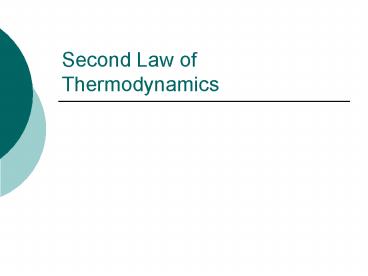Second Law of Thermodynamics - PowerPoint PPT Presentation
1 / 14
Title: Second Law of Thermodynamics
1
Second Law of Thermodynamics
2
Second Law of Thermodynamics
- No cyclic process that converts heat entirely
into work is possible. - W can never be equal to Q.
- Some energy must always be transferred as heat to
the systems surrounding.
3
Cyclic Processes
- A thermodynamic process in which a system returns
to the same conditions under which it started - In a cyclic process, the systems properties at
the end of the process are identical to the
systems properties before the process took
place. - The change in internal energy is zero.
4
Efficiency
- Efficiency is a measure of how well an engine
operates. - EfficiencyWnet Qh-Qc 1- Qh
- Qh energy removed as heat
- Qc energy added as heat
Qh
Qh
Qc
5
Heat Engine
- Find the efficiency of a gasoline engine, that
during one cycle received 204 J of energy from
combustion and loses 153J as heat to the
exhaust. - Qh 204 J
- Qc 153 J
6
Heat Engine
- Choose an equation
- 1- Qc/Qh
- 1-153/204
- .250
7
Carnot Cycle
- The Carnot cycle is a particular thermodynamic
cycle proposed by Nicolas Léonard Sadi Carnot in
1824 and expanded by Benoit Paul Émile Clapeyron
in the 1830s and 40s. A system undergoing a
Carnot cycle is then a (hypothetical) Carnot heat
engine. - A heat engine acts by transferring energy from a
warm region to a cool region of space and, in the
process, converting some of that energy to
mechanical work. The cycle may also be reversed.
The system may be worked upon by an external
force, and in the process, it can transfer
thermal energy from a cooler system to a warmer
one, thereby acting as a heat pump rather than a
heat engine.
8
- What makes the Carnot cycle special, is that it
is the most efficient existing cycle capable of
converting a given amount of thermal energy into
work or, conversely, for using a given amount of
work for refrigeration purposes.
9
The Carnot cycle when acting as a heat engine
consists of the following steps
- 1. Reversible isothermal expansion of the gas at
the "hot" temperature, TH (isothermal heat
addition). During this step (A to B on Figure 1,
1 to 2 in Figure 2) the expanding gas makes the
piston work on the surroundings. The gas
expansion is propelled by absorption of quantity
Q1 of heat from the high temperature reservoir.
10
- 2.Isentropic (Reversible adiabatic) expansion of
the gas (isentropic work output). For this step
(B to C on Figure 1, 2 to 3 in Figure 2) the
piston and cylinder are assumed to be thermally
insulated, thus they neither gain nor lose heat.
The gas continues to expand, working on the
surroundings. The gas expansion causes it to cool
to the "cold" temperature, TC
11
- 3. Reversible isothermal compression of the gas
at the "cold" temperature, TC. (isothermal heat
rejection) (C to D on Figure 1, 3 to 4 on Figure
2) Now the surroundings do work on the gas,
causing quantity Q2 of heat to flow out of the
gas to the low temperature reservoir.
12
- 4. Isentropic compression of the gas(isentropic
work input). (D to A on Figure 1, 4 to 1 in
Figure 2) Once again the piston and cylinder are
assumed to be thermally insulated. During this
step, the surroundings do work on the gas,
compressing it and causing the temperature to
rise to TH. At this point the gas is in the same
state as at the start of step 1.
13
(No Transcript)
14
A real engine on the right and a Carnot engine on
the left































